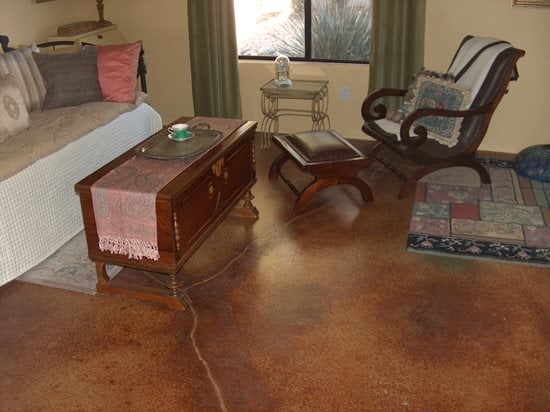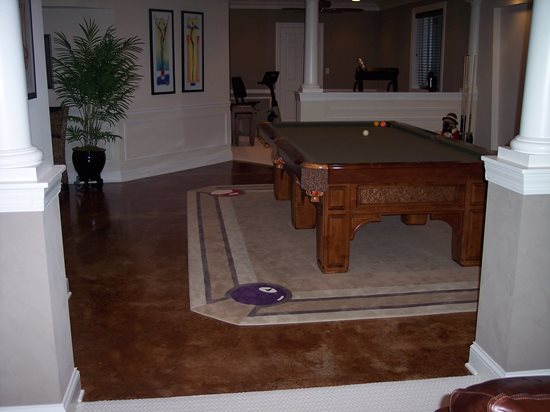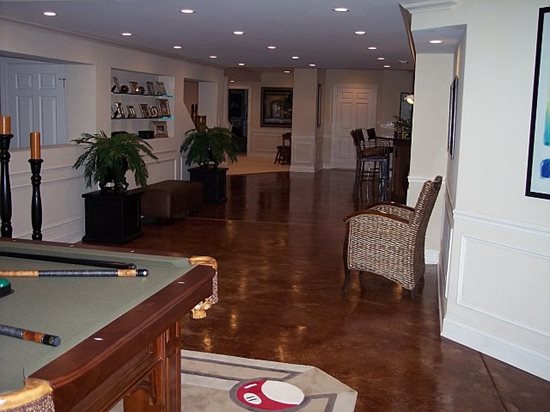- Concrete Basements Home
- Basement Construction Checklist
- Codes for Finished Basements
- Foundation Drainage and Waterproofing: How to keep below-grade spaces dry
- Enhancing & Repairing Existing Basements
- Enhancing Basement Floors: Seven reasons why you should enhance rather than cover up concrete basement floors
- Repairing Bowed Basement Walls: A carbon-fiber-reinforced grid system permanently stabilizes bowed foundation walls with minimal disruption and no excavation
Concrete Basement Floor Myths Busted
Seven reasons why you should enhance rather than cover up concrete basement floorsWhy do so many homeowners bury one of their basement’s most valuable nuggets—the concrete floor? Why do they assume that hiding the concrete under carpeting or other floor coverings is the best way to strike it rich in terms of value and resale potential?
It's time to straighten these homeowners out and bust some of the common myths about the perceived disadvantages of concrete floors. In fact, assuming that the basement and floor are structurally sound, enhancing the concrete rather than covering it up is fast becoming the gold standard in basement floor treatments, with benefits that extend well beyond aesthetics.
Find concrete floor contractors that can help with my basement floors.
Myth #1: Bare concrete floors are cold and damp
"This is rarely true in properly constructed newer homes because they are better insulated than older homes and today's building codes typically require installation of a vapor barrier under the slab to block moisture migration," according to Jerry Kline and Don Henson of Kline Construction, Elgin, Ill., a firm that specializes in stamping, staining, and overlaying of both interior and exterior concrete slabs. They are seeing a growing trend in decorative concrete interior floors, particularly in upscale homes.
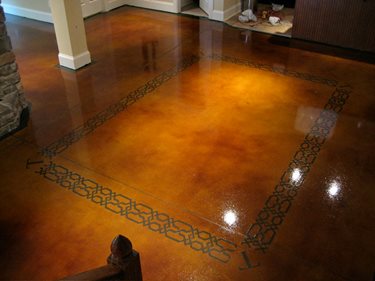

Read about how this concrete basement transformation, using concrete dyes and stencils, improved the look of the basement and decreased allergies by reducing moisture contaminants. The Design Center in Franklin, TN
To keep concrete floors warmer underfoot in winter, homeowners can install in-floor radiant heat before the slab is poured. Basements are one of the most popular areas to install these systems, which circulate heated water through polyethylene tubing. Some systems can also be retrofit into existing basements by covering the tubing with a self-leveling overlay.
Carpet is not recommended on basement floors
Thinking of installing carpeting over an uninsulated or unheated concrete slab? Don't do it, says the Minnesota Department of Commerce Energy Information Center, because the carpet will be susceptible to mold and mildew. The basement floor is generally cooler than the basement air temperature, and installing carpet only lowers the temperature even more. If the basement humidity is high enough, the temperature of the floor under a carpet may, in certain areas, fall below the dew point of the air. Under this condition, a small amount of moisture will accumulate under the carpet, making conditions right for mold growth. The moisture formation may be so slight that you won't see it from the top of the carpet. If the basement floor is already insulated or has under-floor heat, then carpeting or area rugs may work.
Some caveats:
If you have a basement moisture problem, you need to resolve it before installing any floor treatment, especially carpeting. "Even newly placed concrete slabs should be allowed to cure for at least 30 days before decorative staining, coating, or stamping to permit moisture in the slab to evaporate," says Henson. You can easily test for excess moisture by taping a piece of plastic sheeting to the concrete floor and sealing the edges with duct tape. Leave the plastic in place for 24 hours. If condensation accumulates beneath the plastic, then measures must be taken to alleviate the moisture problem. (Read more about excess moisture-vapor transmission in concrete slabs and remedies for prevention and treatment.)
Myth #2: Cracks in concrete are inevitable and it's better to cover them up than to live with them
"Not so," says Henson, "unless the cracks are serious and due to structural issues." In fact, many of Kline Construction's customers like the rustic, fractured look that can be achieved by staining the floor and leaving minor random cracks exposed.
If the cracks are perceived as an eyesore, a polymer-modified cement-based overlay is an easy solution for hiding them and can accept a wide array of decorative treatments, including staining, stamping, and stenciling (see Myth #7).
Myth #3: Carpeting looks warmer and much more inviting than concrete
As the photos here show, concrete stained a rich, earthy tone instantly warms up a room and stands out as one of the basements most attractive features.
With decorative concrete, there's also no risk of chemical emissions, like there are from new carpeting. These emissions can be especially hazardous in basement spaces that aren't well ventilated. Carpets also are a breeding ground for dust mites and other allergens (see Mayo Clinic's recommendations for allergy-proofing a basement and other rooms in the house).
Hardwood flooring isn't a practical covering for most basement slabs because of the potential exposure to moisture and humidity. The solution: Simply apply an overlay to the concrete floor and stamp it with a wood-grain pattern. Kline Construction in Elgin, IL produced this miraculous hardwood floor impersonation using stamps from Butterfield Color.
Myth #4: Covering up or sealing the concrete floor will help to reduce radon infiltration
It won't hurt, but radon, if present in the soil surrounding the basement, can still infiltrate into the home through cracks in the foundation, according to the Environmental Protection Agency. And sealing alone won't lower radon levels significantly or consistently.
Henson points out that for new construction, building codes in his area require radon testing. Basement slabs in newer homes may also require a vapor barrier, which can help to block radon infiltration. In existing homes, a radon test should be taken before starting a basement renovation project. Generally, it's less expensive to install a radon-reduction system during renovations than afterwards. The EPA publication Home Buyers and Sellers Guide to Radon offers additional guidelines for radon testing and for lowering radon levels in the home.
Myth #5: Decorative concrete floors are slippery
In most cases, a decorative concrete floor is no more slippery than vinyl or ceramic tile. Application of a high-gloss sealer to protect and enhance decorative concrete may reduce traction somewhat, but that's easily remedied by mixing a nonslip additive into the stain or sealer before application.
Myth #6: Floor coverings are cheaper to install than decorative concrete
The initial outlay for decorative concrete may exceed the cost of a low-to-mid priced floor covering, such as carpeting, vinyl tile, and wood laminates, but the life expectancy of a concrete floor will far surpass that of most floor covering materials. Decorative concrete can also endure water exposure from occasional seepage into the basement after heavy rains, unlike water-sensitive floor coverings that can peel up, warp, or mildew. That means in the long run homeowners save money because they never need to rip out and replace worn or water-damaged flooring.
When compared with high-end floor coverings, such as ceramic tile, slate, and marble, decorative concrete is often an economical alternative. Plus, skilled concrete artisans can duplicate the look of these pricier materials.
If time is money, then homeowners can also cash in on the low maintenance needs of decorative concrete. Typically just occasional sweeping and damp mopping will keep the floor looking like new for many years. When protected with a good sealer, concrete floors also resist staining, chemicals, and abrasion.
Myth #7: Carpet, vinyl tile, and wood laminate flooring offer more color and design options
This is possibly the biggest myth of all. No flooring material offers more decorative versatility than concrete. A few of the options particularly well-suited for basement floors include stampable and self-leveling overlays, chemical stains, epoxy coatings, paints, dyes, and stenciling. What's more, these treatments can be combined to create one-of-a-kind decorative finishes to suit unique basement design schemes.
Consider these possibilities:
-
Stencil a colorful border or faux area rug on the floor using Modellos, adhesive-backed masking patterns available in more than a thousand standard and custom designs. Applying color with chemical stains or dyes, either before or after the Modello is removed, permits an infinite array of special effects.
-
Install a stamped overlay. Kline Construction says it's possible to resurface most existing basement floors and stamp them to look like slate, stone, and even a hardwood floor. Kline uses a polymer-modified stampable overlay, coloring agents, and stamping tools supplied by Butterfield Color.
-
Basement floor paint: Paint the concrete floor to mimic marble or tile. Use multiple paint colors for contrast or accenting and faux finishing techniques, such as sponging and splattering, to create textural interest.
-
Stain the floor to achieve rich, variegated layers of translucent color. Henson says that using three or four different stain colors will add drama and produce three-dimensional effects.
-
Apply an epoxy coating. High-performance epoxies recommended for basement or garage floors are excellent solutions for spaces where durability is important, such as recreation areas, utility rooms, and workshops. The coatings come in a variety of hues and can be accented with decorative color flakes or chips, as well as metallic pigments. One option is Moisture Blocking Clear Epoxy from Versatile.
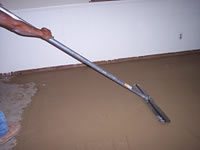
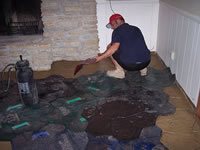
A stampable overlay, applied to a basement floor at a thickness of
about 3/8 inch, is imprinted with a fieldstone pattern to accent a rustic stone fireplace. Kline Construction in Elgin, IL.
All of these floor finishes impart beauty and originality without diminishing concrete's most valuable assets: economy, longevity, and practicality. But a word of caution: If the basement has poor ventilation, avoid the use of solvent-based products, which can emit hazardous fumes. Many concrete stains, dyes, paints, sealers, and epoxies are available in water-based, solvent-free formulations.
